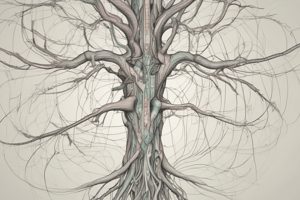Podcast
Questions and Answers
What is the main function of the sensory input in the nervous system?
What is the main function of the sensory input in the nervous system?
- To gather information (correct)
- To activate muscles
- To produce myelin sheath
- To initiate reflexes
What is the role of integration in the nervous system?
What is the role of integration in the nervous system?
To process and interpret sensory input and decide if action is needed.
The motor output in the nervous system activates glands or muscles.
The motor output in the nervous system activates glands or muscles.
True (A)
What makes up the central nervous system?
What makes up the central nervous system?
Which division of the peripheral nervous system is responsible for carrying information to the CNS?
Which division of the peripheral nervous system is responsible for carrying information to the CNS?
What are astrocytes?
What are astrocytes?
What type of cells dispose of debris in the nervous system?
What type of cells dispose of debris in the nervous system?
What do ependymal cells do?
What do ependymal cells do?
The two subdivisions of the motor division are the ______ nervous system and the ______ nervous system.
The two subdivisions of the motor division are the ______ nervous system and the ______ nervous system.
Flashcards are hidden until you start studying
Study Notes
Functions of the Nervous System
- Sensory Input: Gathers information to monitor internal and external changes; these changes are referred to as stimuli.
- Integration: Processes and interprets sensory input, determining necessary actions.
- Motor Output: Activate muscles or glands as a response to integrated stimuli.
Structural Classification of the Nervous System
- Central Nervous System (CNS): Comprises the brain and spinal cord; serves as the integration and command center, interpreting sensory information and issuing instructions.
- Peripheral Nervous System (PNS): Consists of nerves outside the CNS, linking all body parts by carrying impulses to and from the CNS.
Functional Classification of the Peripheral Nervous System
- Sensory (Afferent) Division: Transmits information to the CNS.
- Motor (Efferent) Division: Carries impulses away from the CNS, further subdivided into:
- Somatic Nervous System: A voluntary system controlling skeletal muscles.
- Autonomic Nervous System: An involuntary system with sympathetic and parasympathetic divisions.
Microscopic Anatomy of Skeletal Muscle
- Astrocytes: Abundant, star-shaped cells that:
- Brace neurons and form barriers between capillaries and neurons.
- Control the chemical environment of the brain by capturing ions and neurotransmitters.
- Microglia: Spider-like phagocytes responsible for:
- Disposing of debris, dead cells, and bacteria.
- Ependymal Cells: Line the cavities of the brain and spinal cord; circulate cerebrospinal fluid using cilia.
- Oligodendrocytes: Wrap around nerve fibers in the CNS, producing myelin sheath.
Neuron Cell Body Location
- Most neuron cell bodies are located in the CNS, grouped in clusters known as nuclei.
Studying That Suits You
Use AI to generate personalized quizzes and flashcards to suit your learning preferences.




